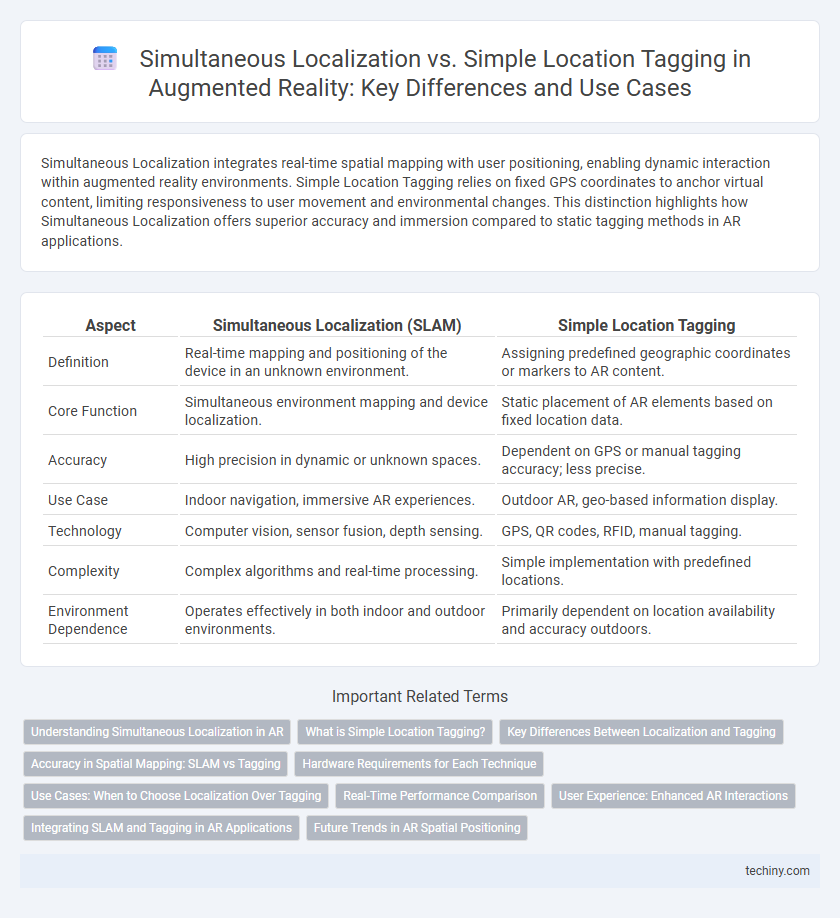Simultaneous Localization integrates real-time spatial mapping with user positioning, enabling dynamic interaction within augmented reality environments. Simple Location Tagging relies on fixed GPS coordinates to anchor virtual content, limiting responsiveness to user movement and environmental changes. This distinction highlights how Simultaneous Localization offers superior accuracy and immersion compared to static tagging methods in AR applications.
Table of Comparison
| Aspect | Simultaneous Localization (SLAM) | Simple Location Tagging |
|---|---|---|
| Definition | Real-time mapping and positioning of the device in an unknown environment. | Assigning predefined geographic coordinates or markers to AR content. |
| Core Function | Simultaneous environment mapping and device localization. | Static placement of AR elements based on fixed location data. |
| Accuracy | High precision in dynamic or unknown spaces. | Dependent on GPS or manual tagging accuracy; less precise. |
| Use Case | Indoor navigation, immersive AR experiences. | Outdoor AR, geo-based information display. |
| Technology | Computer vision, sensor fusion, depth sensing. | GPS, QR codes, RFID, manual tagging. |
| Complexity | Complex algorithms and real-time processing. | Simple implementation with predefined locations. |
| Environment Dependence | Operates effectively in both indoor and outdoor environments. | Primarily dependent on location availability and accuracy outdoors. |
Understanding Simultaneous Localization in AR
Simultaneous Localization in Augmented Reality involves continuously tracking a device's position and orientation within an environment while simultaneously mapping the surrounding space to ensure precise alignment of virtual content. This approach leverages sensor fusion and computer vision algorithms to update spatial data in real-time, enabling immersive and interactive AR experiences. Unlike simple location tagging, which associates virtual objects with fixed GPS coordinates, Simultaneous Localization dynamically adapts to complex indoor or changing environments for enhanced accuracy and user engagement.
What is Simple Location Tagging?
Simple Location Tagging in augmented reality refers to the process of assigning fixed geographic coordinates to virtual content, enabling users to view digital information anchored at specific real-world locations. Unlike Simultaneous Localization and Mapping (SLAM), which dynamically maps environments and tracks user positions, simple location tagging relies on GPS or predefined markers without continuous spatial updates. This approach is ideal for applications that require minimal interaction with the environment and lower computational demand.
Key Differences Between Localization and Tagging
Simultaneous Localization and Mapping (SLAM) enables augmented reality devices to build real-time 3D maps while tracking their position, ensuring precise spatial understanding and dynamic interaction within an environment. Simple location tagging assigns static, predefined coordinates or markers to objects or points, lacking real-time positional updates and environmental mapping capabilities. The key difference lies in SLAM's ability to continuously localize and map simultaneously for immersive AR experiences, whereas location tagging provides fixed reference points without environment adaptability.
Accuracy in Spatial Mapping: SLAM vs Tagging
Simultaneous Localization and Mapping (SLAM) offers superior accuracy in spatial mapping by dynamically creating and updating a map of the environment while tracking the user's position in real time. Simple location tagging relies on fixed, predefined markers, resulting in limited precision and reduced adaptability to changing environments. SLAM's advanced sensor fusion and real-time processing enable highly accurate spatial understanding, essential for complex augmented reality applications.
Hardware Requirements for Each Technique
Simultaneous Localization and Mapping (SLAM) requires advanced sensors such as depth cameras, LiDAR, and inertial measurement units (IMUs) to continuously map environments and track device position in real-time. Simple Location Tagging relies on GPS modules and basic cameras, demanding significantly lower hardware capabilities with less emphasis on real-time spatial mapping. The high processing power and sensor fusion in SLAM systems enable precise augmented reality experiences, whereas location tagging suits applications with static, geotagged content.
Use Cases: When to Choose Localization Over Tagging
Simultaneous Localization (SLAM) excels in dynamic environments where real-time tracking and interaction with 3D space are crucial, such as in AR navigation, gaming, and industrial maintenance. Simple Location Tagging suits static contexts like indoor mapping or basic content overlay, where precise spatial awareness is less critical. Choose SLAM for immersive applications requiring continuous environment mapping and choose tagging for straightforward, location-based AR experiences.
Real-Time Performance Comparison
Simultaneous Localization and Mapping (SLAM) in augmented reality enables real-time environment mapping and user localization, significantly outperform simple location tagging that relies on predefined GPS coordinates. SLAM algorithms process sensor data continuously to update position and orientation dynamically, achieving higher accuracy and responsiveness in complex, indoor, or GPS-denied environments. The real-time performance of SLAM substantially enhances user experience by allowing seamless interaction with 3D virtual objects anchored precisely to the physical space.
User Experience: Enhanced AR Interactions
Simultaneous Localization and Mapping (SLAM) significantly improves user experience in augmented reality by enabling devices to understand and map their environment in real-time, allowing for precise interaction with virtual objects anchored in physical space. In contrast, simple location tagging relies on predefined GPS coordinates, which often leads to less accurate positioning and less immersive AR interactions. SLAM-driven AR delivers seamless spatial awareness, enhancing the realism and interactivity crucial for applications such as gaming, navigation, and industrial design.
Integrating SLAM and Tagging in AR Applications
Integrating SLAM (Simultaneous Localization and Mapping) with simple location tagging enhances AR applications by providing real-time, accurate environment mapping alongside contextual information overlays. SLAM continuously updates spatial positioning, enabling dynamic interaction with the environment, while tagging anchors virtual objects to fixed points for persistent user engagement. This synergy improves both the precision of spatial awareness and the richness of augmented content, resulting in more immersive and reliable AR experiences.
Future Trends in AR Spatial Positioning
Simultaneous Localization and Mapping (SLAM) advances enable AR systems to dynamically map environments while tracking user positions, significantly enhancing spatial accuracy compared to simple location tagging. Emerging trends emphasize integrating AI-driven SLAM algorithms with 5G connectivity to support real-time, large-scale AR experiences. Future AR spatial positioning will prioritize robust multi-sensor fusion and cloud-based processing to deliver seamless interaction in complex, dynamic environments.
Simultaneous Localization vs Simple Location Tagging Infographic

 techiny.com
techiny.com